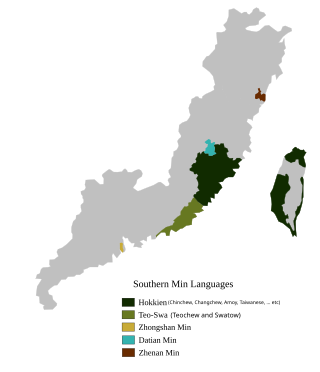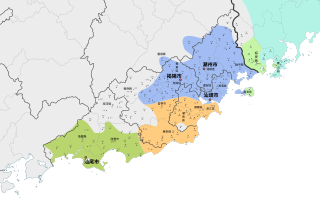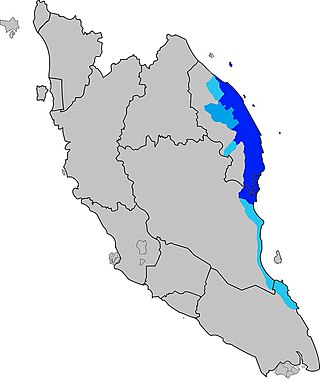Related Research Articles
Manglish is an informal form of Malaysian English with features of an English-based creole principally used in Malaysia. It is heavily influenced by the main languages of the country, Malay, Chinese languages, and Tamil. It is not one of the official languages spoken in Malaysia.

Min is a broad group of Sinitic languages with about 70 million native speakers. These languages are spoken in Fujian province as well as by the descendants of Min-speaking colonists on the Leizhou Peninsula and Hainan and by the assimilated natives of Chaoshan, parts of Zhongshan, three counties in southern Wenzhou, the Zhoushan archipelago, Taiwan and scattered in pockets or sporadically across Hong Kong, Macau, and several countries in Southeast Asia, particularly Singapore, Malaysia, the Philippines, Indonesia, Thailand, Myanmar, Cambodia, Vietnam, Brunei. The name is derived from the Min River in Fujian, which is also the abbreviated name of Fujian Province. Min varieties are not mutually intelligible with one another nor with any other variety of Chinese.

Southern Min, Minnan or Banlam, is a group of linguistically similar and historically related Chinese languages that form a branch of Min Chinese spoken in Fujian, most of Taiwan, Eastern Guangdong, Hainan, and Southern Zhejiang. Southern Min dialects are also spoken by descendants of emigrants from these areas in diaspora, most notably in Southeast Asia, such as Singapore, Malaysia, the Philippines, Indonesia, Brunei, Southern Thailand, Myanmar, Cambodia, Southern and Central Vietnam, San Francisco, Los Angeles and New York City. Minnan is the most widely-spoken branch of Min, with approximately 48 million speakers as of 2017–2018.

Kelantan is a state in Malaysia. The capital, Kota Bharu, includes the royal seat of Kubang Kerian. The honorific name of the state is Darul Naim. Kelantan is the only state outside of East Malaysia that does not use the term district in its second-level administrative division. Instead, the divisions are called colonies or collectivities with one autonomous subdistrict.

Terengganu, formerly spelled Trengganu or Tringganu, is a sultanate and federal state of Malaysia. The state is also known by its Arabic honorific, Dāru l-Īmān. The coastal city of Kuala Terengganu, which stands at the mouth of the broad Terengganu River, is both the state and royal capital as well as the most populous city in Terengganu. Other major cities and towns includes Jerteh, Kuala Dungun, Chukai, Kuala Berang, Marang, and Permaisuri. At 13,035 square kilometres in size and a population of over 1.2 million people in 2023, Terengganu is Malaysia's 7th largest state by area and 10th largest in population. Terengganu, along with Kelantan, Perlis, and the Federal Territory of Putrajaya, is one of the most homogeneous states/territories in the country of which 95% of the population are ethnic Malay-Muslims with its own distinct language/dialect, culture, history, and tradition.

In linguistics, mutual intelligibility is a relationship between languages or dialects in which speakers of different but related varieties can readily understand each other without prior familiarity or special effort. It is sometimes used as an important criterion for distinguishing languages from dialects, although sociolinguistic factors are often also used.

The Hoklo people are a Han Chinese subgroup who speak Hokkien, a Southern Min language, or trace their ancestry to southeastern Fujian in China, and known by various related terms such as Banlam people, Minnan people, or more commonly in Southeast Asia as the Hokkien people. The Hokkien people are found in significant numbers in mainland China, Taiwan, Singapore, Malaysia, Philippines, Indonesia, Brunei, Myanmar, the United States, Hong Kong, and Macau. The Hokkien people have a distinct culture and architecture, including Hokkien shrines and temples with tilted sharp eaves, high and slanted top roofs, and finely detailed decorative inlays of wood and porcelain. The Hokkien language, which includes Taiwanese Hokkien, is the mainstream Southern Min, which is partially mutually intelligible to the Teochew language, Hainanese, Leizhou Min, and Haklau Min.

The languages of Taiwan consist of several varieties of languages under the families of Austronesian languages and Sino-Tibetan languages. The Formosan languages, a geographically designated branch of Austronesian languages, have been spoken by the Taiwanese indigenous peoples for thousands of years. Owing to the wide internal variety of the Formosan languages, research on historical linguistics recognizes Taiwan as the Urheimat (homeland) of the whole Austronesian languages family. In the last 400 years, several waves of Han emigrations brought several different Sinitic languages into Taiwan. These languages include Taiwanese Hokkien, Hakka, and Mandarin, which have become the major languages spoken in present-day Taiwan.

Bachok District is an administrative division of Kelantan, Malaysia. It is located approximately 25 km east of Kota Bharu.

In linguistics, a koine or koiné language or dialect is a standard or common dialect that has arisen as a result of the contact, mixing, and often simplification of two or more mutually intelligible varieties of the same language.

The Amoy dialect or Xiamen dialect, also known as Amoyese, Amoynese, Amoy Hokkien, Xiamenese or Xiamen Hokkien, is a dialect of Hokkien spoken in the city of Xiamen and its surrounding metropolitan area, in the southern part of Fujian province. Currently, it is one of the most widely researched and studied varieties of Southern Min. It has historically come to be one of the more standardized varieties.
Temuan language is a Malayic language spoken by the Temuan people, one of the Orang Asli or indigenous peoples of Peninsular Malaysia which can be found in the states of Selangor, Pahang, Johor, Malacca and Negeri Sembilan. Temuan is a separate language but has a degree of mutual intelligibility with the Malay language. It is written in a Latin alphabet, but no standard orthography has been made.

Hokkien is a variety of the Southern Min languages, native to and originating from the Minnan region, in the southeastern part of Fujian in southeastern mainland China. It is also referred to as Quanzhang, from the first characters of the urban centers of Quanzhou and Zhangzhou.

Haklau, or Hai Lok Hong, is a variety of Southern Min spoken in Shanwei, Guangdong province, China. While it is related to Teochew and Hokkien, its exact classification in relation to them is disputed.
Medan Hokkien is a local variety of Hokkien spoken amongst Chinese Indonesians in Medan, North Sumatra, Indonesia. It is the lingua franca in Medan as well as the surrounding cities in the state of North Sumatra. It is also spoken in some Medan Chinese migrant communities such as in Jakarta. Medan Hokkien is a subdialect of the Zhangzhou (漳州) Hokkien, particularly of Haicheng (海澄) subdialect. It borrows heavily from Teochew, Deli Malay and Indonesian.

Terengganu Malay is a Malayic language spoken in the Malaysian state of Terengganu all the way southward to coastal Pahang and northeast Johor. It is the native language of Terengganu Malays and highly localized Chinese Peranakan community as well as a second language among the smaller Indian minority.

Apam balik also known as martabak manis, terang bulan, peanut pancake or mànjiānguǒ, is a sweet dessert originating in Fujian cuisine which now consists of many varieties at specialist roadside stalls or restaurants throughout Brunei, Indonesia, Malaysia and Singapore. It can also be found in Hong Kong as, Taiwan as, Southern Thailand as Khanom Thang Taek (ขนมถังแตก) and in the Sulu Archipelago, Philippines as Tarambulan.

Kelantanese Malays are a sub-ethnic group of Malays native to the state of Kelantan, Malaysia as well as in Northern Terengganu. The Kelantanese Malays are closely related to Thai Malays and Terengganuan Malays in neighbouring Terengganu, these two Malay sub-ethnic groups shared historical, cultural and linguistic as well as kinship ties with the Kelantanese Malays. Kelantanese Malays form 94% of Kelantan's population, which makes them the largest ethnic group in Kelantan and around 150,000 in Besut, Terengganu.
Reman Malay, also known by several names such as Patani, Baling, Grik and Tukugho, is a Malayic language spoken in the states of Kedah and Perak in northern Peninsular Malaysia. In the state of Kedah it is spoken in the districts of Baling, Padang Terap, Sik and Yan while in Perak it is spoken in Hulu Perak but also in some areas within Kerian and Larut, Matang and Selama districts, especially in the towns of Batu Kurau and Bukit Gantang. Despite being located within these two states, Reman Malay is not closely related to neighbouring Kedahan and Perakian varieties but instead more closely related or an offshoot of Kelantan-Patani Malay.
References
- 1 2 "Reclassifying ISO 639-3 [nan]: An Empirical Approach to Mutual Intelligibility and Ethnolinguistic Distinctions" (PDF). Archived from the original (PDF) on 2021-09-19.